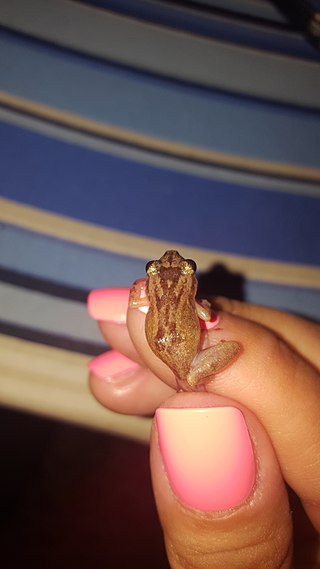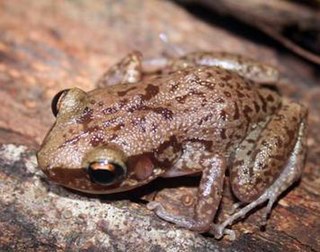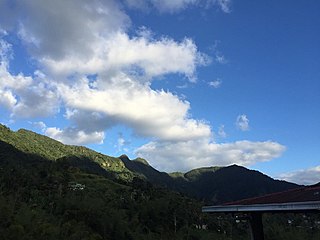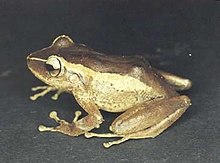
The geography of Puerto Rico consists of an archipelago located between the Caribbean Sea and the North Atlantic Ocean, east of Hispaniola, and west of the Virgin Islands and north of Venezuela. The main island of Puerto Rico is the smallest and most eastern of the Greater Antilles. With an area of 8,897 square kilometres (3,435 sq mi), it is the third largest island in the United States and the 82nd largest island in the world. Various smaller islands and cays, including Vieques, Culebra, Mona, Desecheo, and Caja de Muertos comprise the remainder of the archipelago with only Culebra and Vieques being inhabited year-round. Mona is uninhabited through large parts of the year except for employees of the Puerto Rico Department of Natural Resources.

El Yunque National Forest, formerly known as the Caribbean National Forest, is a forest located in northeastern Puerto Rico. It is the only tropical rainforest in the United States National Forest System and the United States Forest Service. El Yunque National Forest is located on the slopes of the Sierra de Luquillo mountains, encompassing more than 28,000 acres of land, making it the largest block of public land in Puerto Rico.

The common coquí or coquí is a species of frog native to Puerto Rico belonging to the family Eleutherodactylidae. The species is named for the loud call the males make at night. This sound serves two purposes. "CO" serves to repel other males and establish territory while the "KEE" serves to attract females. Since the auditory systems of males and females respond preferentially to different notes of the male call, this is an example of a sex difference in a sensory system. The common coquí is a very important aspect of Puerto Rican culture, and it has become an unofficial territorial symbol of Puerto Rico. The frog is also found elsewhere, and is usually considered an invasive species outside Puerto Rico.

The golden coquí is a rare, possibly extinct species of frog endemic to Puerto Rico.

Cordillera Central, is the main mountain range in Puerto Rico. The range crosses the island from west to east and divides it into its northern and southern coastal plains. The Cordillera Central runs eastward from the municipality of Maricao in the west to Aibonito in the central eastern region, and on to the Caribbean in the southeast through the Sierra de Cayey.

Eleutherodactylus is a genus of frogs in the family Eleutherodactylidae. Many of the 200 species of the genus are commonly known as "rain frogs" or "robber frogs", due to their sharp, high-pitched, insect-like calls.

The web-footed coqui, stream coqui, Puerto Rican stream frog or Karl's robber frog, is a possibly extinct Puerto Rican frog species in the family Eleutherodactylidae. It was first described by Chapman Grant in 1931, and was named after herpetologist Karl Patterson Schmidt. It is the largest Eleutherodactylus species of Puerto Rico.

The whistling coquí, Cochran's treefrog, or Cochran's robber frog is a species of frog native to Puerto Rico, the US Virgin Islands, and the British Virgin Islands. This nocturnal insectivore is also referred to as the coquí pitito in Puerto Rico. Their distinctive song is a single, rising whistle, which is repeated and followed by three clicking sounds.
Coquí is a common name for several species of small frogs in the genus Eleutherodactylus native to Puerto Rico. They are onomatopoeically named for the very loud mating call which the males of two species, the common coqui and the upland coqui, make at night. The coquí is one of the most common frogs in Puerto Rico, with more than 16 different species found within its territory, including 13 in El Yunque National Forest. Other species of this genus can be found in the rest of the Caribbean and elsewhere in the Neotropics, in Central and South America. The coquí is an unofficial national symbol of Puerto Rico; there is a Puerto Rican expression that goes, "Soy de aquí, como el coquí", which translates to "I'm from here, like the coquí."

The red-eyed coqui, churi, coqui churi, or coqui de las Antillas is a species of frog in the family Eleutherodactylidae that is found in Puerto Rico, the British and U.S. Virgin Islands, and introduced to Panama. Although there are many similar species that are endemic to these tropical locations, its unique physical, habitual, and behavioral characteristics distinguish it from other members of the genus Eleutherodactylus. This genus contains around 185 species that are located in the southern United States, Central America, South America, and the Caribbean, with 16 different species endemic to Puerto Rico. The red-eyed coqui was not brought into Panama City from its native habitats until the late 1960s. There it became established in urban parks before it began to colonize outside the city in the 1980s. In Puerto Rico, the largest island inhabited by the red-eyed coqui, it is found up to 1,200 meters above sea level. It is often compared to the common coqui, Puerto Rico's unofficial territorial symbol, but upon a closer ecological look, the red-eyed coqui has many differences.

Hedrick's coqui, the treehole coqui, or coqui de Hedrick is a species of frog in the family Eleutherodactylidae endemic to Puerto Rico. Its natural habitats are subtropical or tropical moist lowland forest and subtropical or tropical moist montane forest.

The Mona coqui, coqui de la Mona or coqui de Mona, is a species of frog in the family Eleutherodactylidae endemic to Mona, Puerto Rico. Its natural habitats are subtropical or tropical dry forest and subtropical or tropical dry shrubland.

Eleutherodactylus juanariveroi, or the Puerto Rican wetland frog, is an endangered species of coqui, a frog species, endemic to Puerto Rico. It was discovered in 2005 by Neftalí Rios, and was named after Puerto Rican herpetologist Juan A. Rivero, in honor of his contributions to Puerto Rican herpetology.

The Puerto Rican rock frog, also known as the Puerto Rican cave-dwelling frog or rock coqui, and locally as coquí guajón, or guajón for brevity, is a threatened frog species from the coqui genus. This unique species of tropical frogs dwells primarily in crevices and grottos in the Cuchilla de Panduras mountain range in southeastern Puerto Rico. The native name guajón is derived from its habitat, guajonales, which are caves formed by rock formations between huge stones. Despite being the state animal and considered emblematic of the region, of the 17 species of coquí, three are believed to be extinct and the rest are rare and declining in numbers. The Puerto Rican rock frog is extremely restricted in geographical distribution. The frog is threatened due to deforestation, agricultural, rural, and industrial development, and the associated infrastructure. It is sometimes called the “demon of Puerto Rico" because of its eerie call and phantom-like appearance. The species was first described by American herpetologist, Chapman Grant in 1932.

The Puerto Rican moist forests are a tropical moist broadleaf forest ecoregion in Puerto Rico. They cover an area of 7,544 km2 (2,913 sq mi).

Carite State Forest is a state forest and nature reserve located in the Sierra de Cayey mountain range in southeastern Puerto Rico. The forest extends over approximately 2,600 hectares and is located in the municipalities of Caguas, Cayey, Guayama, Patillas and San Lorenzo. The forest is located along the Ruta Panorámica, which offers access to the forest.

Guilarte State Forest is one of the 20 forests that make up the public forests system in Puerto Rico. The forest is located in the eastern half of the Central Mountain Range or Cordillera Central. The main geographical feature of the forest reserve is Monte Guilarte, which is Puerto Rico's 7th highest mountain at 3,950 feet above sea level. While Monte Guilarte is located in the municipality of Adjuntas, the forest's borders also include parts of Guayanilla, Peñuelas and Yauco.

Los Tres Picachos State Forest is one of the 20 forests that make up the public forest system of Puerto Rico. The forest is located in the Central Mountain Range or Cordillera Central, along the Los Tres Picachos mountain ridge, one of the island's highest mountains, named after the distinctive three peaks of the highest mountain in the forest. The state forest is located in the municipalities of Jayuya and Ciales.

Sierra Pandura, also known as Cuchilla de Pandura and La Pica, is a mountain range that runs from the Sierra de Cayey in the northwest to the Caribbean Sea in the southeast in southeastern Puerto Rico, between the municipalities of Maunabo and Yabucoa. Together with the Sierra de Guardarraya to the south, Sierra Pandura is part of the San Lorinzo batholith physiological region, a composite body of volcanic origin which bifurcates the mountain ridge.



















